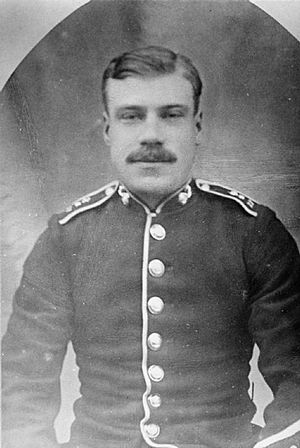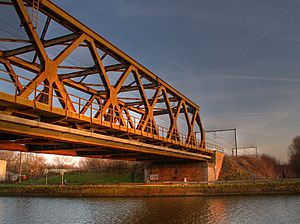Sidney Godley facts for kids
Quick facts for kids
Sidney Frank Godley
|
|
|---|---|
 |
|
| Born | 16 August 1889 East Grinstead, Sussex |
| Died | 29 June 1957 (aged 67) Epping, Essex |
| Buried |
Loughton Town Cemetery, Loughton
|
| Allegiance | |
| Service/ |
|
| Years of service | 1909–1919 |
| Rank | Private |
| Service number | 13814 |
| Unit | The Royal Fusiliers 4th battalion |
| Battles/wars | World War I |
| Awards | Victoria Cross |
Sidney Frank Godley (born August 14, 1889 – died June 29, 1957) was a brave English soldier. He received the Victoria Cross, which is the highest award for courage in battle for British and Commonwealth forces. Sidney Godley was the very first private soldier to earn this special medal during World War I.
Contents
Early Life and Joining the Army
Sidney Godley was born on August 14, 1889, in East Grinstead, West Sussex. When he was seven years old, his mother passed away. He then went to live with his aunt and uncle in Willesden, London.
Sidney went to school at Henry Street School and later at Sidcup National School. From age 14 to 20, he worked in a shop that sold metal tools and hardware. On December 13, 1909, he joined the British Army. He became a private soldier in The Royal Fusiliers (City of London Regiment).
Heroic Actions at Mons
Sidney Godley was 25 years old when World War I began. He was a soldier in the 4th Battalion of The Royal Fusiliers. On August 23, 1914, his unit was fighting in the Battle of Mons in Belgium.
During this battle, Sidney Godley and Lieutenant Maurice Dease were operating a machine gun. They were defending the Nimy Railway Bridge. Other soldiers who had been using the machine gun were either killed or hurt.
Lieutenant Dease was badly wounded, but he kept fighting. Sadly, he was later killed. When the order came to retreat, Private Godley bravely offered to stay behind. He would defend the bridge by himself while the rest of his group got to safety.
Defending the Bridge Alone
Sidney Godley held the bridge all alone under very heavy enemy fire. He was wounded twice. A piece of a shell hit him in the back, and a bullet wounded his head. Even with these injuries, he kept defending the bridge. This allowed his comrades to escape.
His award citation said: "For coolness and gallantry in fighting his machine gun under a hot fire for two hours after he had been wounded at Mons on 23 August." This means he stayed calm and brave, fighting for two hours even after being hurt.
A book called The Royal Fusiliers in the Great War described his actions. It said that machine gun crews were constantly being hit. Lieutenant Dease kept going to check on the guns, even though it was very dangerous. When Dease was fatally wounded, Godley stepped forward. He got the gun working again under heavy fire.
Captured and Honored
Sidney Godley defended the bridge for two hours until he ran out of ammunition. His last act was to take the machine gun apart and throw the pieces into the canal. He tried to crawl to safety, but German soldiers captured him.
He was taken to a prisoner of war camp. His wounds were treated there. He stayed in the camp until the war ended. At first, everyone thought he had been killed. But later, it was discovered he was a prisoner of war in a camp called Delotz.
It was in the camp that he learned he had been awarded the Victoria Cross. After the war ended, Godley left the camp in 1918. He received his medal from King George V at Buckingham Palace on February 15, 1919.
Life After the War
On August 2, 1919, Sidney Godley married Ellen Eliza Norman. He worked as a school caretaker in Tower Hamlets, London.
Sidney Godley passed away in Epping Hospital on June 29, 1957. He was buried with full military honors in the town cemetery at Loughton, Essex. This was the town where he lived later in his life.
Sidney Godley's story was even shown on TV. He was played by actor Theo Barklem-Biggs in the BBC Three series Our World War in 2014.
Remembering a Hero
Many memorials honor Sidney Godley's bravery:
- The Town Council in East Grinstead placed a Blue Plaque on their offices.
- Loughton Town Council also put a Blue Plaque at 164 Torrington Drive. This remembers him as a famous former resident. On August 23, 2014, exactly 100 years after he defended the bridge at Mons, a special service was held at his grave.
- In 1976, a new group of houses in Bexley, London, was named after him.
- In 1992, Tower Hamlets Council named a block of flats "Godley VC House." A plaque there also honors him.
- In 2014, the government gave a special paving stone to the hometown of every World War I Victoria Cross winner. The paving stone in East Grinstead was unveiled on August 23, 2014. It is placed at the base of the war memorial in East Grinstead High Street.
- A small residential area in Saint-Symphorien near Mons, Belgium, is named Clos Sidney Godley.
Images for kids



